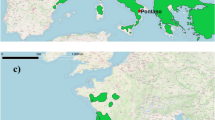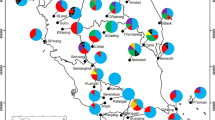Abstract
DNA variation was studied at the intra- andinterspecific levels within the genus Passiflora, with particular emphasis on the subgenusTacsonia and its relationship with the subgenusPassiflora. AFLP fingerprints were generated for35 accessions from 21 species, 14 of which belong to subgenusTacsonia, and four to subgenusPassiflora. The morphologically intermediateP. manicata (subgenusManicata) was also included, as wereP. trinervia (subgenusPsylanthus) and P.alnifolia (subgenus Decaloba). The two latter were used as outgroup species. Twoprimer combinations generated 34–80 scorable fragments pergenotype for a total of 260 fragments. Polymorphism analyses spannedthe levels from individual genotype to section. SubgenusTacsonia presented wide genetic variability atboth intra- and interspecific levels, particularly within wildspecies. The classification based on these markers generally agreeswell with current taxonomic definitions of common species, but lesswith definitions of sections. A geographical component was evident inthe intraspecific variation of P.mixta, P.tripartita var. mollissimaand P. tarminiana, withwider variation in Ecuador and Peru than in Colombia and Venezuela.These same three species, plus P.cumbalensis, formed adjacent clusters, showingcloser affinity with each other than with the other species ofsubgenus Tacsonia. As expected, P. manicata clustered at anintermediate position between subgenera Tacsoniaand Passiflora.
Similar content being viewed by others
References
Caicedo A.L. 1996. Caracterización molecular de especies silves-tres suramericanas de Phaseolus por medio de AFLPs. Tesis de Pregrado, Departamento de Ciencias Biológicas, Facultad de Ciencias. p. 146. Universidad de los Andes, Santafé de Bogotá, Colombia.
Cervera M.T., Cabezas J.A., Sancha J.C., Martínez de Toda F. and Martínez Zapater J.M. 1998. Application of AFLPs to the characterization of grapevine Vitis vinifera L. genetic resources. A case study with accessions from Rioja (Spain). Theoretical and Applied Genetics 97: 51–59.
Coppens d'Eeckenbrugge G., Barney V.E., Møller Jørgensen P. and MacDougal J. 1988. Passiflora tarminiana, a new cultivated species of Passiflora subgenus Tacsonia. Novon.
Dirlewanger E., Pronier V., Parvery C., Rothan C., Guye A. and Monet R. 1998. Genetic linkage map of peach (Prunus persica (L.) Batsch) using morphological and molecular markers. Theoretical and Applied Genetics 97: 888–895.
Escobar L.A. 1985. Biología reproductiva de Passiflora manicata e hibridación con la curuba, Passiflora mollissima. Actualidades Biológicas 14: 111–121.
Escobar L.A. 1988. Passifloraceae. In: Pinto P. and Lozano G. (eds), Flora de Colombia. Universidad Nacional de Colombia, Bogotá, Colombia.
Fajardo D., Angel F., Grum M., Tohme J., Lobo M., Roca W.M. et al. 1998. Genetic variation analysis of the genus Passiflora using RAPD markers. Euphytica 10: 341–347.
GIBCO 1998.LP Analysis system I. AFLP Starter primer kit.
González D., Palacios N., Gallego G. and Tohme J. 1995. Protocolos para marcadores moleculares. Documento de trabajo No. 258. CIAT, Cali, Colombia, pp. 82.
Holm-Nielsen L., Jørgensen P.M. and Lawesson J.E. 1988. Passifloraceae. In: Harling G. and Anderson L. (eds), Flora of Ecuador Vol. 31. University of Goteborg, Copenhagen.
Kardolus J.P., vanEck H.J. and van den Berg R.G. 1998. The potential of AFLPs in biosystematics: a first application in Solanum taxonomy (Solanaceae). Plant System. Evol. 210: 87–103.
Killip E.P. 1938. The American species of Passifloraceae. Field Museum of Natural History Botanical, Chicago, 613 p. 2.
MacDougal J.M. 1994. Revision of Passiflora subgenus Decaloba section Pseudodysosmia (Passifloraceae) Systematic Botany Monographs. Amer. Soc. Plant Taxonomists, Ann. Arbor, Michigan 41, 146 p.
Maliepaard C., Alston F.H., van Arkel G., Brown L.M., Chevreau E., Dunemann F. et al. 1998. Aligning male and female linkage maps of apple (Malus pumila Mill.) using multi-allelic markers. Theoretical and Applied Genetics 97: 60–73.
Nei M. and Li W.H. 1979. Mathematical model for studying genetic variation in terms of restriction endonucleases. Proc. Natl. Acad. Sci. 76: 5269–5273.
Nurhaimi H. 1997. AFLP for differentiating clonal oil palm trees producing normal and mantled fruits. Warta Pusat Penelitian Bioteknologi Perkebunan 3: 41–42.
Perrier X. and Jacquemound-Collect J.P. 1998. DARWIN. CIRADFLHOR, Montpellier, Version 3.0.
Polashock J.J., Vorsa N., Yarborough D.E. and Smagula J.M. 1997. Evaluation of fingerprinting techniques for differentiation of cranberry and blueberry varieties. In Proceedings of the sixth international symposium on Vaccinium culture. no 446 12–17 August 1996:, pp. 239–242.
Rahman M.S.M., Shimada T., Yamamoto T., Yonemoto J.Y. and Yoshida M. 1998. Genetical diversity of cherimoya cultivars revealed by amplified fragment length polymorphism (AFLP) analysis. Breeding Science 48: 5–77.
Roa A.C., Maya M.M., Duque M.C., Tohme J., Allem A.C. and Bonierbale M.W. 1997. AFLP analysis of relationships among cassava and other Manihot species. Theoretical and Applied Genetics 95: 741–750.
Sánchez I., Angel F., Grum M., Duque M.C., Lobo M. and Tohme J. 1999.Variability of chloroplast DNA in the genus Passiflora. Euphytica 106: 15–26.
Schoëniger G. 1986. La Curuba. Técnicas para el mejoramiento de su cultivo. Editora Guadalupe Ltda, Bogotá, Colombia, p. 255.
Segura S.D., Coppens d'Eeckenbrugge G. and Ollitrault P. 1998. Isozyme variation in five species of Passiflora subgenus Tacsonia and Passiflora manicata XLIV Annual Meeting of the Interamer. Soc. Trop. (eds.). Barquisimeto, Venezuela. September 28–October 2, 1998.
Segura S.D., Guarino L., Coppens d'Eeckenbrugge G., Grum M. and Ollitrault P. 1999. Mapping the distribution and regions climatically suitable for four species in Passiflora subgenus Tacsonia (Passifloraceae) and P. manicata. Poster presented at II Simposio de Recursos Genéticos para America Latina e Caribe. SIRGEALC, Brasília, Brasil, 21–26 November.
Villacis L.A., Vega J., Grum M. and Coppens d'Eeckenbrugge G. 1998. Morphological characterization of Andean Passifloras (Passiflora spp.) from Ecuador. Plant Genetic Resources Newsletter 115: 51–55.
Vos P., Hogers R., Bleeker M., Reijans M., van de Lee T., Hornes M. et al. 1995. AFLP: a new technique for DNA fingerprinting. Nucleic acids research 23: 4407–4414.
Author information
Authors and Affiliations
Rights and permissions
About this article
Cite this article
Segura, S., Coppens d'Eeckenbrugge, G., Bohorquez, A. et al. An AFLP diversity study of the genus Passiflora focusing on subgenus Tacsonia . Genetic Resources and Crop Evolution 49, 111–123 (2002). https://doi.org/10.1023/A:1014731922490
Issue Date:
DOI: https://doi.org/10.1023/A:1014731922490




